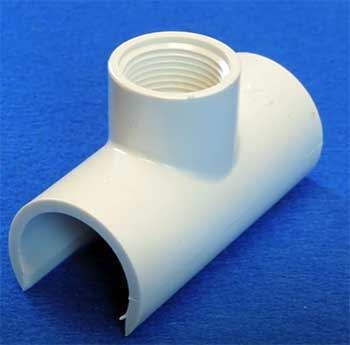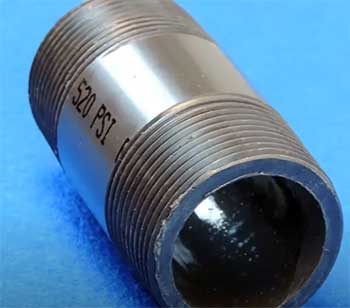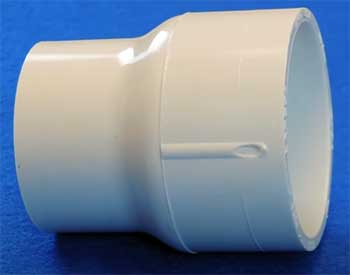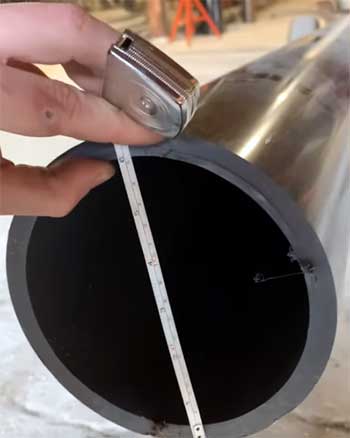I’ve spent years working with PVC fittings in plumbing projects, from backyard irrigation to industrial setups, and I’ve learned one thing: choosing between Schedule 40 and Schedule 80 PVC fittings can make or break your system.
In this article, I’ll walk you through the key differences, weighing the pros and cons of each to help you decide which fits your needs.
Whether you’re a DIY enthusiast or a professional, my goal is to break down the technical details into practical insights, so you can confidently select the right PVC for your project.
A Brief Comparison Table
| Feature | Schedule 40 PVC Fittings | Schedule 80 PVC Fittings |
| Wall Thickness | Thinner walls | Thicker walls |
| Pressure Rating | Up to 450 PSI (varies by size) | Up to 630 PSI (varies by size) |
| Cost | More affordable | More expensive |
| Weight | Lighter | Heavier |
| Common Applications | Residential plumbing, irrigation | Industrial, high-pressure systems |
| Durability | Moderate | High |
| Ease of Installation | Easier to cut and join | Requires more effort to cut |
| Corrosion Resistance | Excellent | Excellent |
| Color | White or clear | Gray or dark gray |
| Availability | Widely available | Less common, specialty stores |
What Are Schedule 40 And Schedule 80 PVC Fittings?

When I first started working with PVC, the term “schedule” threw me off.
It sounds technical, but it’s straightforward.
The “schedule” refers to the wall thickness of the pipe or fitting, which directly affects its strength and pressure-handling capacity.
Schedule 40 has thinner walls, while Schedule 80 is beefier.
Both are made from polyvinyl chloride (PVC), a versatile, corrosion-resistant material that’s a go-to for plumbing, irrigation, and even some structural projects.
I remember my first project—a simple garden irrigation system. I grabbed Schedule 40 fittings because they were cheaper and easier to find at the local hardware store. But when I moved on to a high-pressure industrial setup, Schedule 80 became my best friend.
The difference lies in their design and purpose, and understanding that can save you from costly mistakes.
Key Features of Schedule 40 PVC Fittings
Schedule 40 PVC fittings are the workhorse of the plumbing world. Here’s what makes them stand out:
- Thinner Walls: The walls of Schedule 40 fittings are thinner than Schedule 80, making them lighter and easier to handle. I’ve carried armfuls of these to job sites without breaking a sweat.
- Pressure Ratings: Depending on the diameter, Schedule 40 can handle pressures up to 450 PSI for smaller sizes (like ½-inch pipes). That’s plenty for most home plumbing or irrigation systems.
- Cost-Effective: These fittings are budget-friendly. When I was setting up a drip irrigation system for my backyard, I saved a good chunk of change by sticking with Schedule 40.
- Versatility: From drainage to potable water systems, Schedule 40 is everywhere. It’s the default choice for residential projects because it’s reliable and widely available.
- Ease of Use: Cutting and joining Schedule 40 fittings is a breeze. I’ve used a simple hacksaw and PVC cement to assemble systems in no time.
But it’s not all sunshine. Schedule 40’s thinner walls mean it’s less durable under high pressure or in harsh environments. I learned this the hard way when a Schedule 40 pipe burst during a pressure test for an industrial project—lesson learned.
Pros And Cons of Schedule 40 PVC Fittings
Let’s break down the advantages and drawbacks of Schedule 40, based on my experience:
Pros
- Affordable: Schedule 40 fittings are significantly cheaper. For large projects, like when I plumbed an entire greenhouse, this kept costs down.
- Lightweight: Their lighter weight makes them easy to transport and install, especially for overhead work.
- Widely Available: You’ll find Schedule 40 at any hardware store, from big chains to local shops.
- Easy to Work With: Cutting, gluing, and fitting Schedule 40 is straightforward, even for beginners. I taught my nephew how to assemble a basic system in an afternoon.
- Suitable for Most Residential Needs: Whether it’s for drinking water, drainage, or irrigation, Schedule 40 handles most home projects with ease.
Cons
- Lower Pressure Tolerance: Schedule 40 isn’t built for high-pressure systems. I’ve seen it fail in setups exceeding its rated PSI.
- Less Durable: The thinner walls are more prone to cracking under impact or extreme conditions.
- Not Ideal for Industrial Use: If you’re dealing with chemicals or high-pressure fluids, Schedule 40 might not cut it.
Key Features of Schedule 80 PVC Fittings
Schedule 80 PVC fittings are the heavy-duty cousins of Schedule 40. Here’s what you need to know:

- Thicker Walls: The thicker walls give Schedule 80 fittings superior strength. I’ve seen these hold up in systems where pressure spikes would’ve cracked Schedule 40.
- Higher Pressure Ratings: Schedule 80 can handle up to 630 PSI for smaller diameters, making it ideal for industrial applications like chemical processing or high-pressure water systems.
- Durability: These fittings are built to last. I’ve used them in outdoor setups exposed to extreme weather, and they’ve held up without a hitch.
- Corrosion Resistance: Like Schedule 40, Schedule 80 is immune to rust and chemical degradation, which is why I trust it for projects involving aggressive fluids.
- Gray Color: Schedule 80 is typically gray, which helps distinguish it from white Schedule 40 fittings on job sites.
The downside? Schedule 80 is pricier and heavier. Cutting it requires more elbow grease, and it’s not always stocked at every hardware store. I once drove across town to find a specific Schedule 80 elbow fitting—annoying, but worth it for the project’s demands.
Pros And Cons of Schedule 80 PVC Fittings
Now, let’s look at Schedule 80’s strengths and weaknesses:
Pros
- High Strength: The thicker walls make Schedule 80 fittings incredibly robust. I’ve used them in systems that run 24/7 without issues.
- Higher Pressure Capacity: With ratings up to 630 PSI, Schedule 80 is a must for high-pressure applications like industrial fluid transfer.
- Long-Lasting: These fittings can withstand harsh environments, from freezing winters to scorching summers.
- Chemical Resistance: Schedule 80 is a go-to for systems handling corrosive substances, which is why I used it for a chemical plant project.
Cons
- Expensive: Schedule 80 costs more—sometimes double the price of Schedule 40. Budget-conscious projects might feel the pinch.
- Heavy: The thicker walls add weight, which can be a hassle for large installations or overhead work.
- Harder to Work With: Cutting and joining Schedule 80 takes more effort. I’ve burned through a few saw blades tackling these.
- Limited Availability: You might need to visit a specialty supplier to find Schedule 80 fittings, which can slow down your project.
When To Use Schedule 40 PVC Fittings?

Schedule 40 is my go-to for most residential projects.
If you’re setting up a sprinkler system, plumbing a bathroom, or running a drain line, Schedule 40 is usually enough.
Its lower cost and ease of use make it perfect for DIYers or anyone working on a budget.
I’ve used it for everything from pool plumbing to greenhouse irrigation, and it’s never let me down for low-to-moderate pressure applications.
However, you need to know its limits. If your system will face pressures above 450 PSI or extreme physical stress, Schedule 40 might crack under pressure—literally. I once saw a homeowner try to use Schedule 40 for a high-pressure pump system, and the result was a flooded basement.
When To Use Schedule 80 PVC Fittings?
Schedule 80 is the choice for heavy-duty applications. If you’re working on an industrial project, like a chemical processing line or a high-pressure water system, Schedule 80’s thicker walls and higher pressure ratings are non-negotiable.
I’ve used it in factories where pipes had to withstand constant vibration and pressure spikes. It’s also great for outdoor systems exposed to harsh weather or physical impacts.
That said, don’t overdo it. Using Schedule 80 for a simple home irrigation system is like using a sledgehammer to crack a walnut—overkill and expensive. Stick to Schedule 80 when the project demands extra durability or pressure handling.
Comparing Applications in Real-World Scenarios
Let’s get practical. Imagine you’re plumbing a new home. For the potable water lines, Schedule 40 is likely fine, as most residential water systems operate well below its pressure limits.
It’s also NSF-certified for drinking water, so you’re safe there. I’ve installed countless Schedule 40 systems for homes, and they’ve performed flawlessly.
Now, picture an industrial setup, like a factory moving corrosive chemicals. Schedule 80 is the better bet. Its thicker walls can handle the pressure and resist chemical degradation. I worked on a project where Schedule 80 fittings were used for a cooling system in a manufacturing plant, and they’ve been running smoothly for years.
For mixed scenarios—like a greenhouse with both irrigation and chemical fertilizer lines—consider using Schedule 40 for the low-pressure irrigation and Schedule 80 for the chemical lines. Just be cautious about mixing them, which I’ll cover in the FAQ.
Installation and Handling Differences

Installing Schedule 40 is a walk in the park.
The thinner walls mean you can cut it with a basic hacksaw or PVC cutter, and gluing it with PVC cement is quick.
I’ve put together entire systems in a weekend with minimal tools.
The lightweight nature also makes it easy to maneuver, especially in tight spaces.
Schedule 80, on the other hand, is a bit of a beast.
The thicker walls require a sturdier saw, and you’ll need more force to cut cleanly.
Gluing is the same process, but the heavier fittings can be trickier to align perfectly.
I’ve found that having a ratchet cutter or a power saw makes a big difference for Schedule 80 projects.
One tip from experience: always deburr the cut edges on both types to ensure a tight seal. A rough edge can lead to leaks, and trust me, fixing a leak after the system is up and running is no fun.
Cost Considerations
Cost is a big factor. Schedule 40 fittings are typically 30-50% cheaper than Schedule 80. For a small project, like a backyard sprinkler system, the savings add up quickly.
I once saved a client hundreds of dollars by using Schedule 40 for a non-critical drainage system instead of over-specifying with Schedule 80.
But don’t let cost blind you. If your project demands Schedule 80’s strength, skimping can lead to failures that cost way more to fix. I’ve seen burst pipes in industrial setups that could’ve been avoided by investing in Schedule 80 upfront.
Environmental And Safety Factors
Both Schedule 40 and Schedule 80 are corrosion-resistant and safe for a wide range of environments. They don’t rust, and they’re resistant to most chemicals, which is why I love using PVC for outdoor projects.
Both are also NSF-certified for potable water, so you don’t have to worry about safety for drinking water systems.
However, Schedule 80’s thicker walls give it an edge in extreme conditions. If your pipes are exposed to freezing temperatures or physical impacts (like in a construction site), Schedule 80 is less likely to crack. I’ve seen Schedule 40 fittings fail in cold climates when water froze inside, expanding the pipe.
Long-Term Performance
In terms of longevity, both schedules can last decades if installed correctly. Schedule 40 systems in my home have been running for over 15 years with no issues.
Schedule 80, with its extra durability, can go even longer in harsh conditions. I’ve seen Schedule 80 systems in factories still performing after 20 years of heavy use.
Maintenance is minimal for both. Keep them clean, avoid excessive pressure, and check for cracks periodically. One thing I’ve noticed: Schedule 40 is more prone to damage from UV exposure, so if your system is outdoors, consider painting it or using UV-resistant tape.
Making The Right Choice For Your Project
Choosing between Schedule 40 and Schedule 80 comes down to your project’s demands. Ask yourself:
- What’s the pressure rating you need?
- Is the system exposed to harsh chemicals or weather?
- What’s your budget?
- How easy does installation need to be?
For most home projects, Schedule 40 is your best bet for its affordability and ease. For industrial or high-pressure systems, Schedule 80 is worth the investment. I’ve made the mistake of cutting corners before, and it’s not worth the headache of repairs.
Frequently Asked Questions (FAQ)
Yes, but it’s not always recommended. They have the same outer diameter, so they can connect, but the different wall thicknesses can cause issues with pressure ratings and flow. I’ve mixed them in low-pressure systems without problems, but always consult local codes.
Schedule 80 is used for high-pressure or industrial applications, like chemical processing, high-pressure water systems, or environments with harsh conditions. I’ve seen it in factories and large-scale irrigation systems.
Use Schedule 80 when your system faces high pressures (above 450 PSI), corrosive chemicals, or extreme physical stress. It’s my go-to for industrial projects or outdoor systems in tough climates.
Yes, Schedule 80 is NSF-certified for potable water and safe for domestic use. I’ve used it in homes where extra durability was needed, like in high-pressure municipal water lines.
Wrapping Up
You’ve got a project ahead, and choosing between Schedule 40 and Schedule 80 PVC fittings is a big decision. I’ve shared my experiences to help you weigh the pros and cons, from cost and ease of use to durability and pressure handling.
Schedule 40 is your affordable, versatile choice for most home projects, while Schedule 80 steps up for heavy-duty demands.
Use the comparison table and insights to pick what’s right for you. If you’re still unsure, drop me a question—I’m happy to help you make the best choice for your setup.
